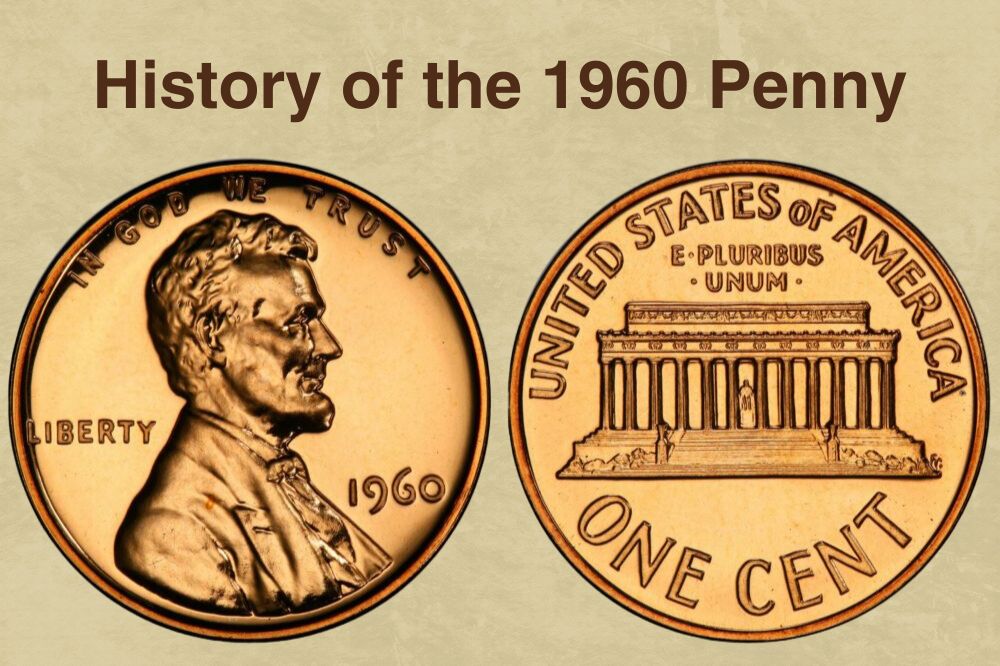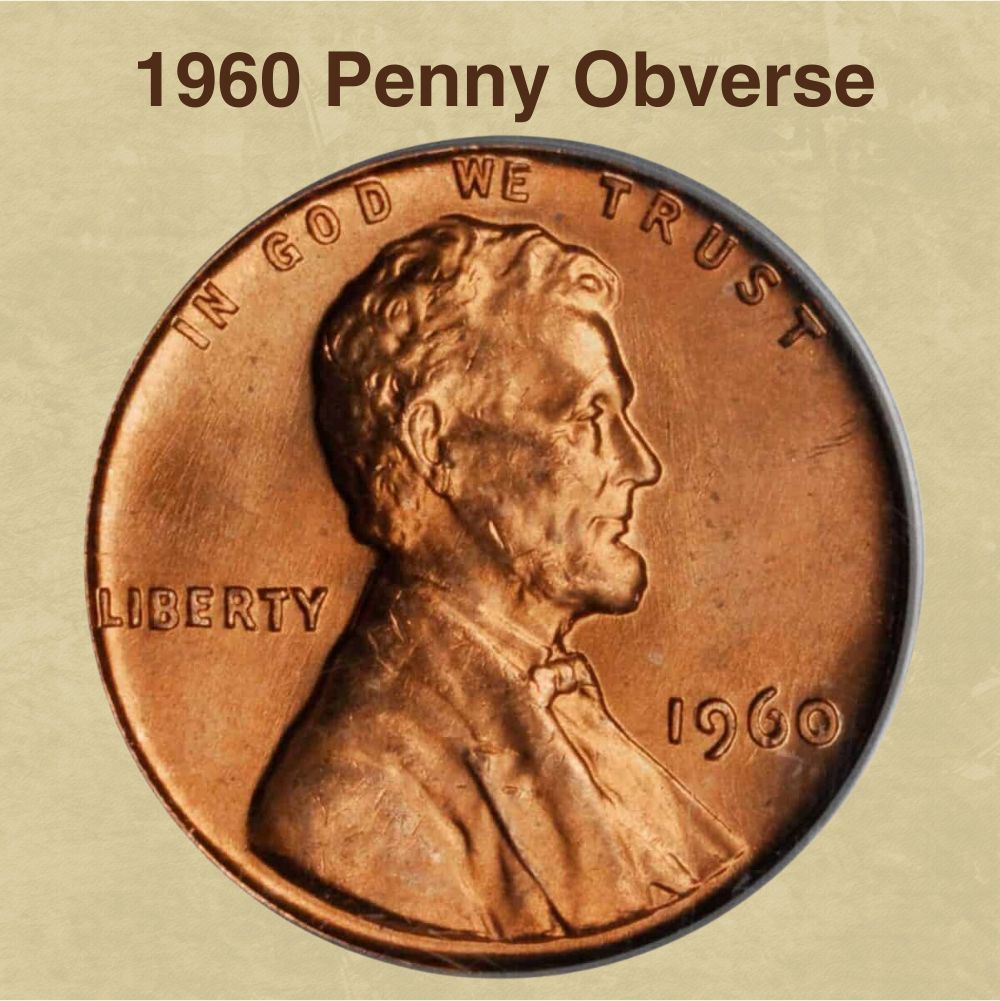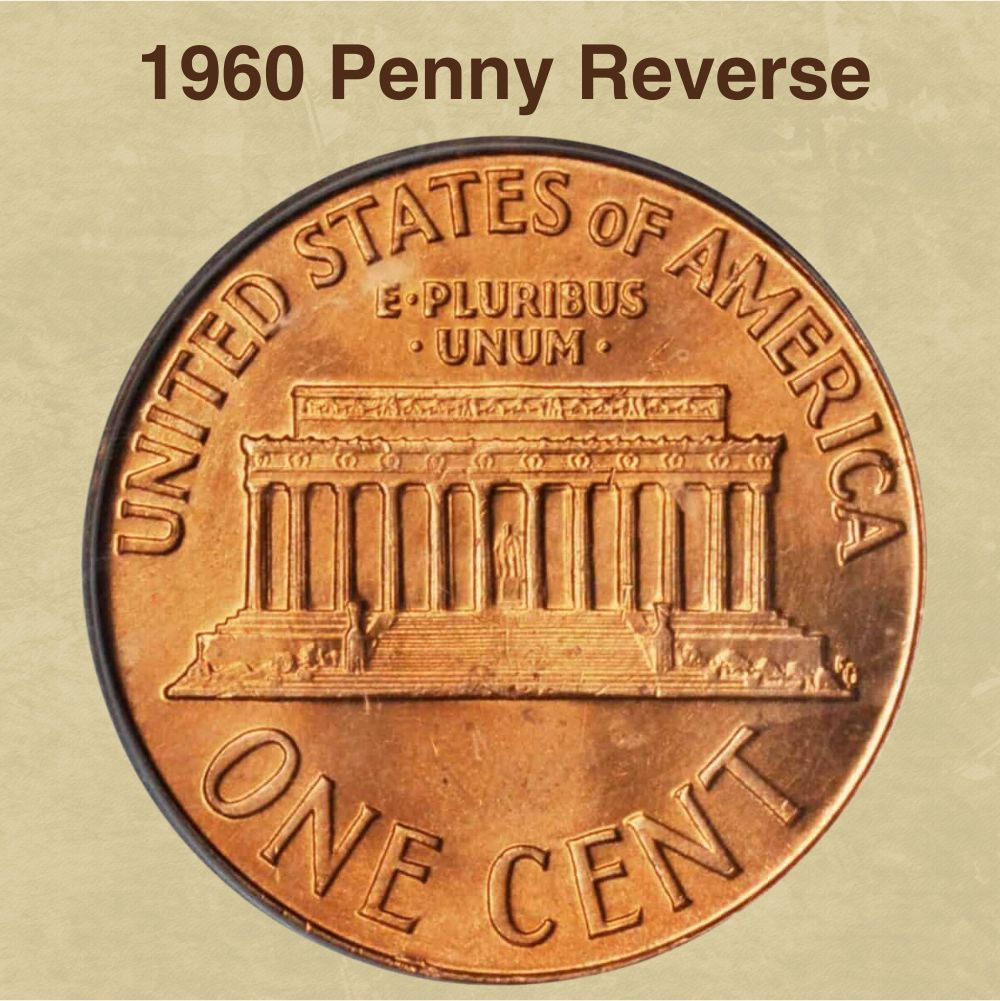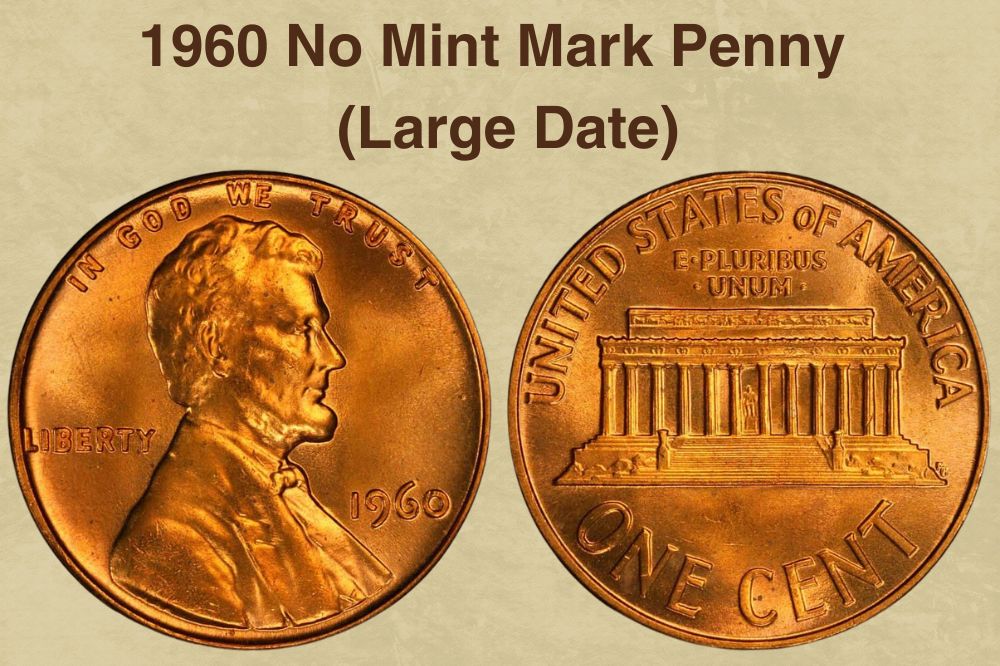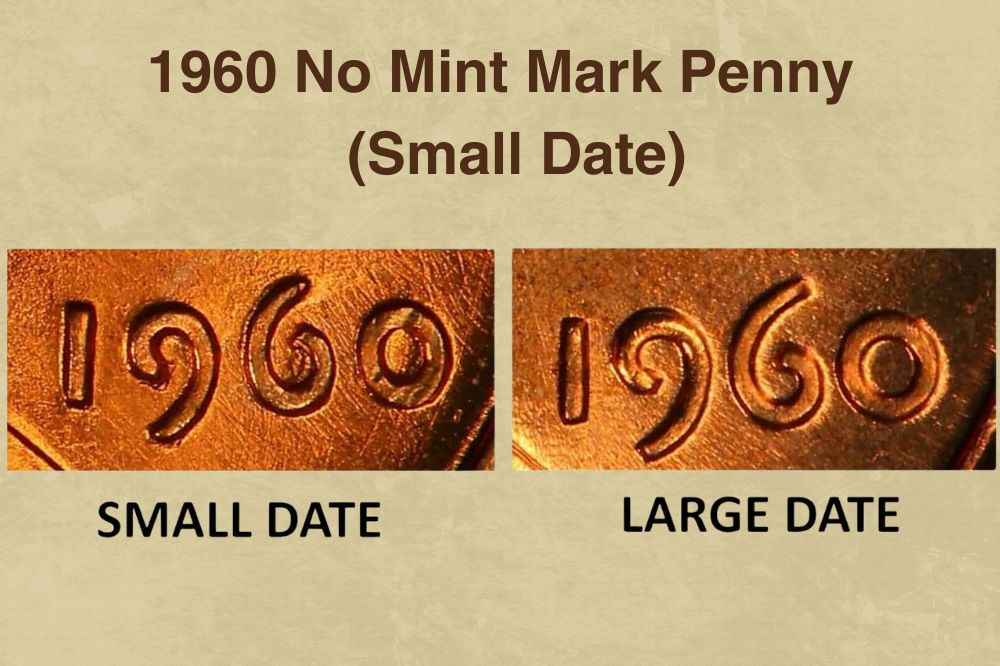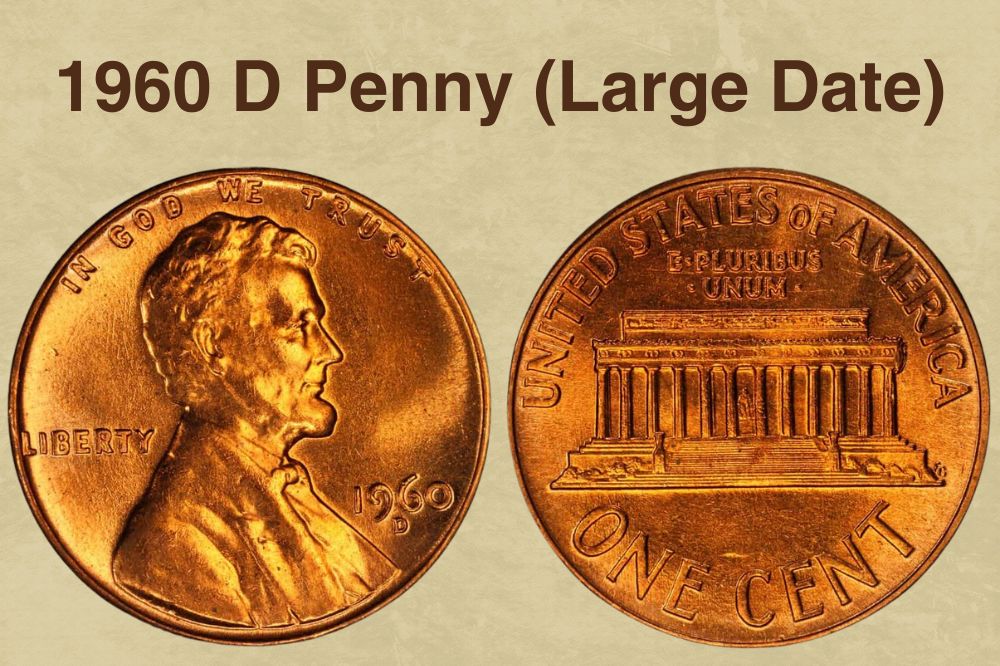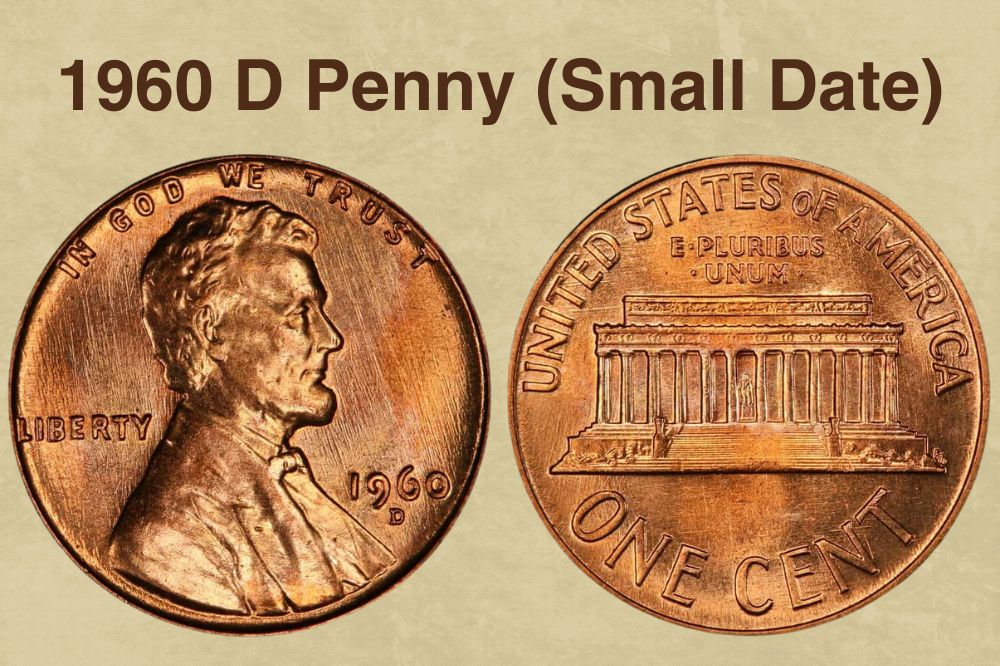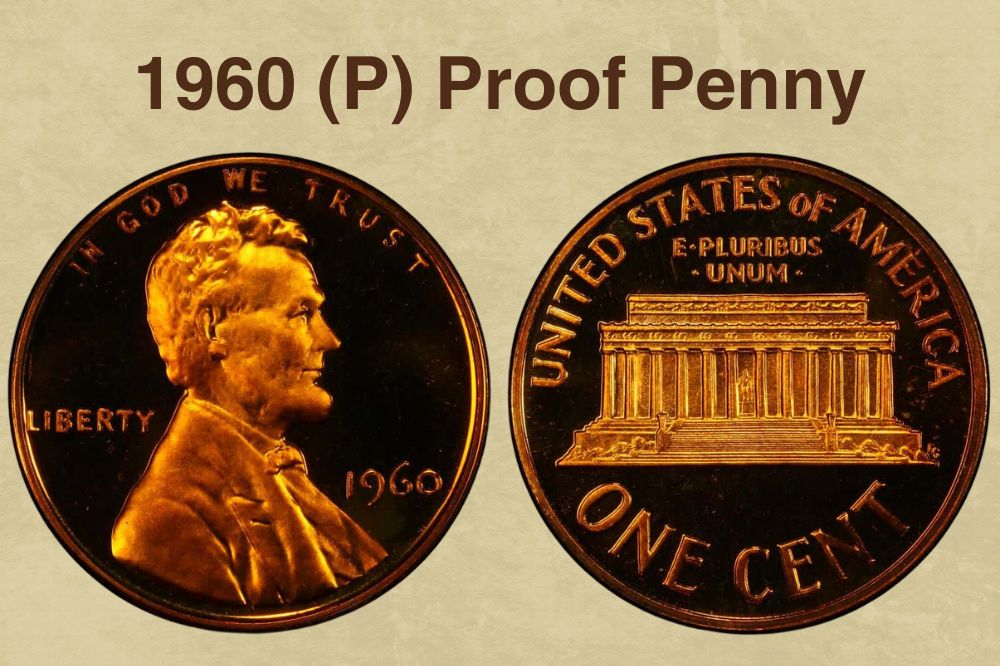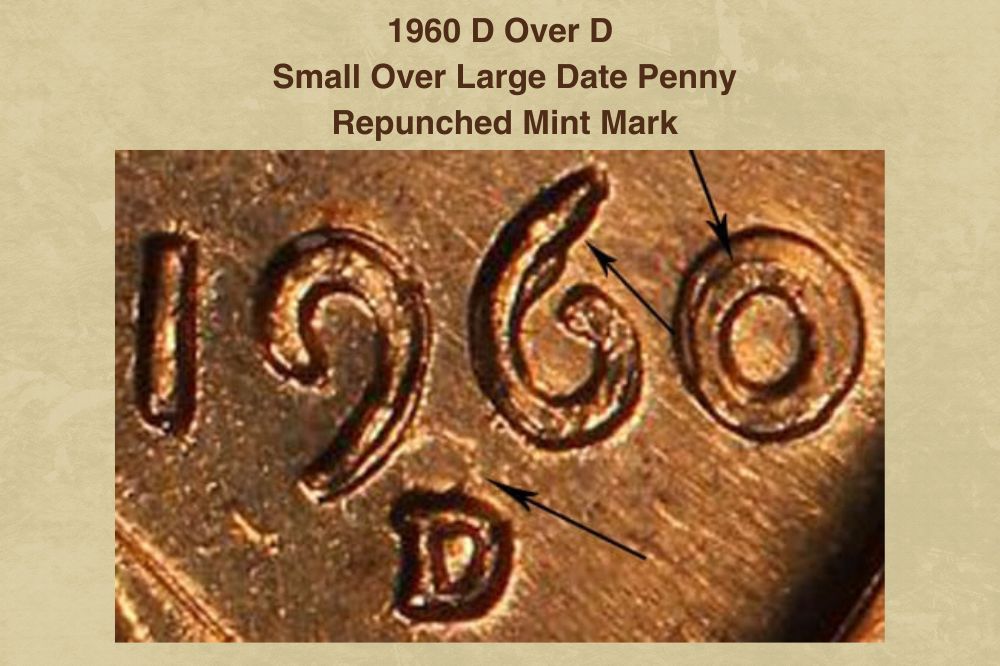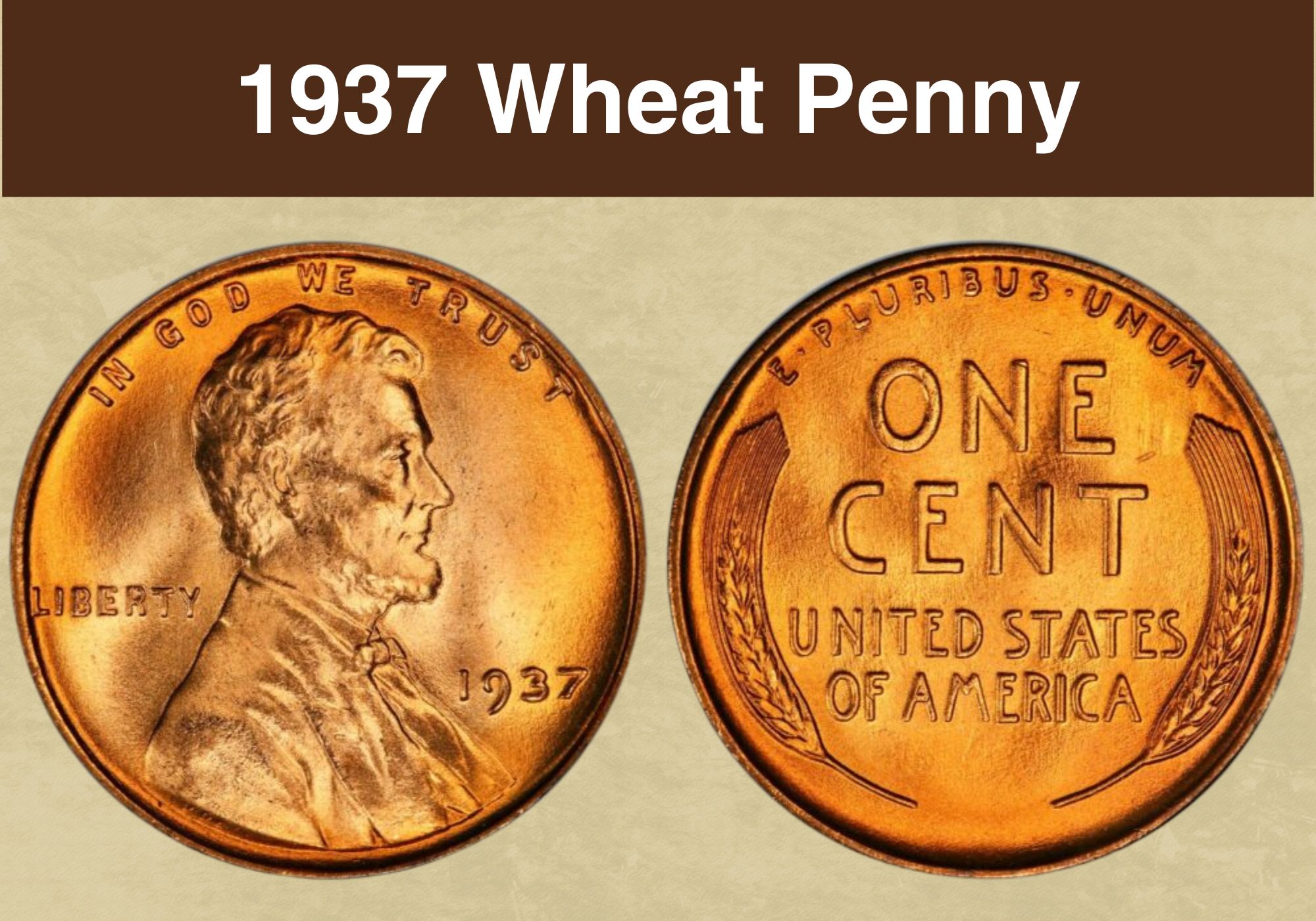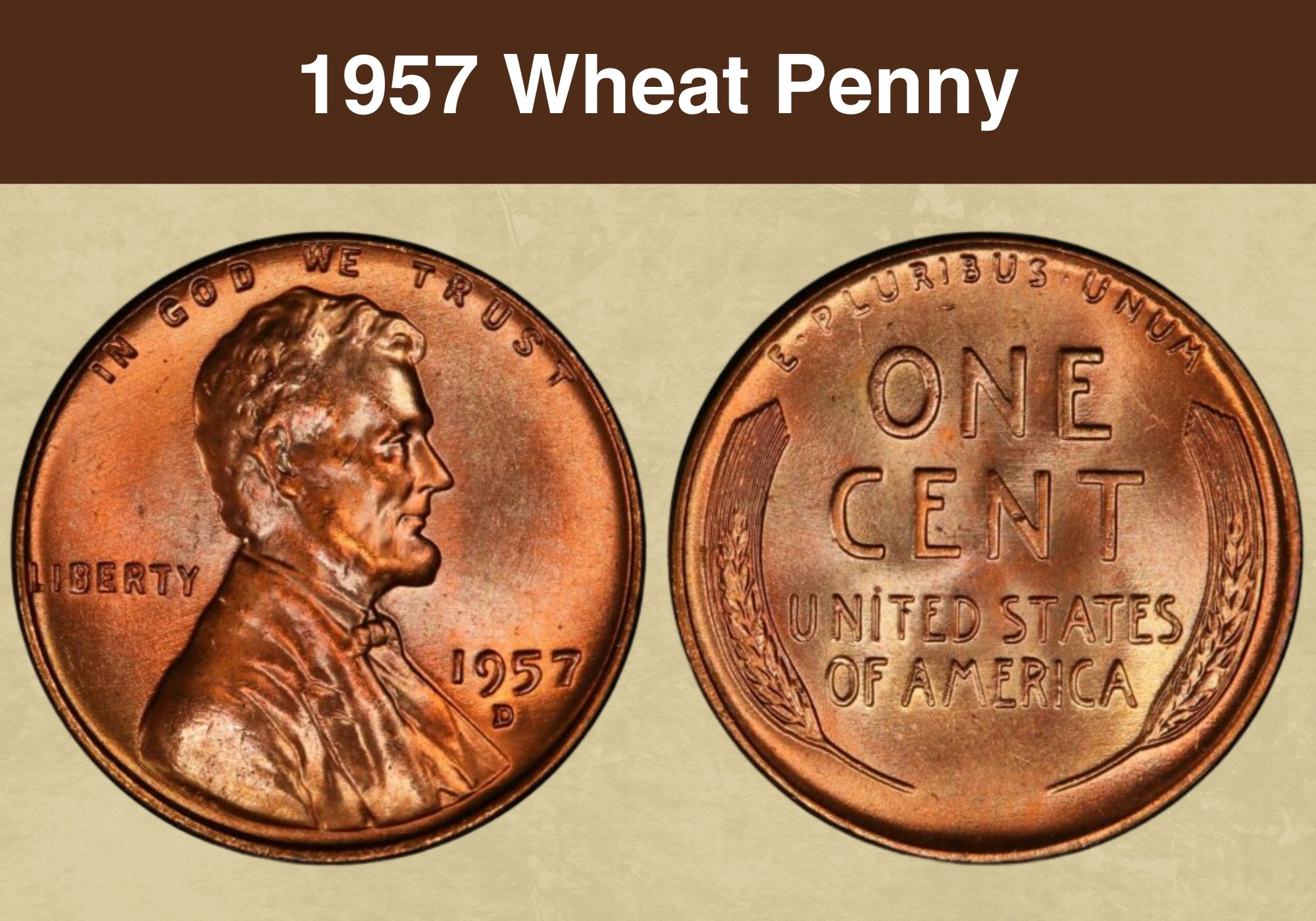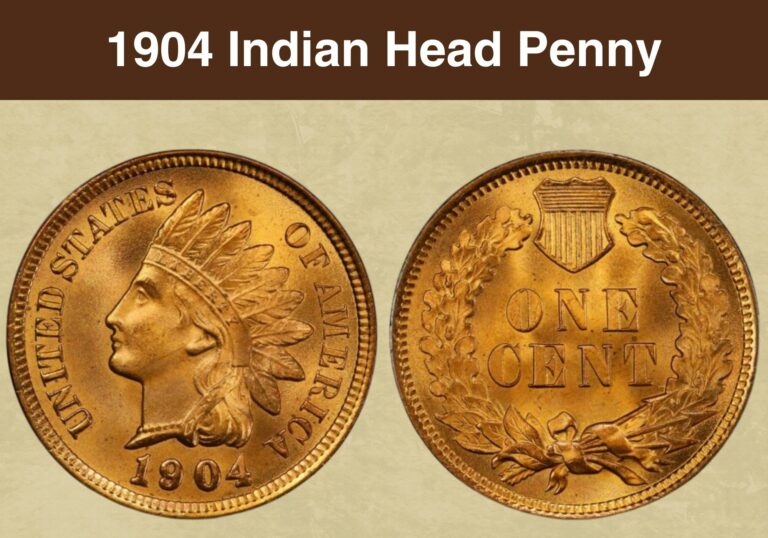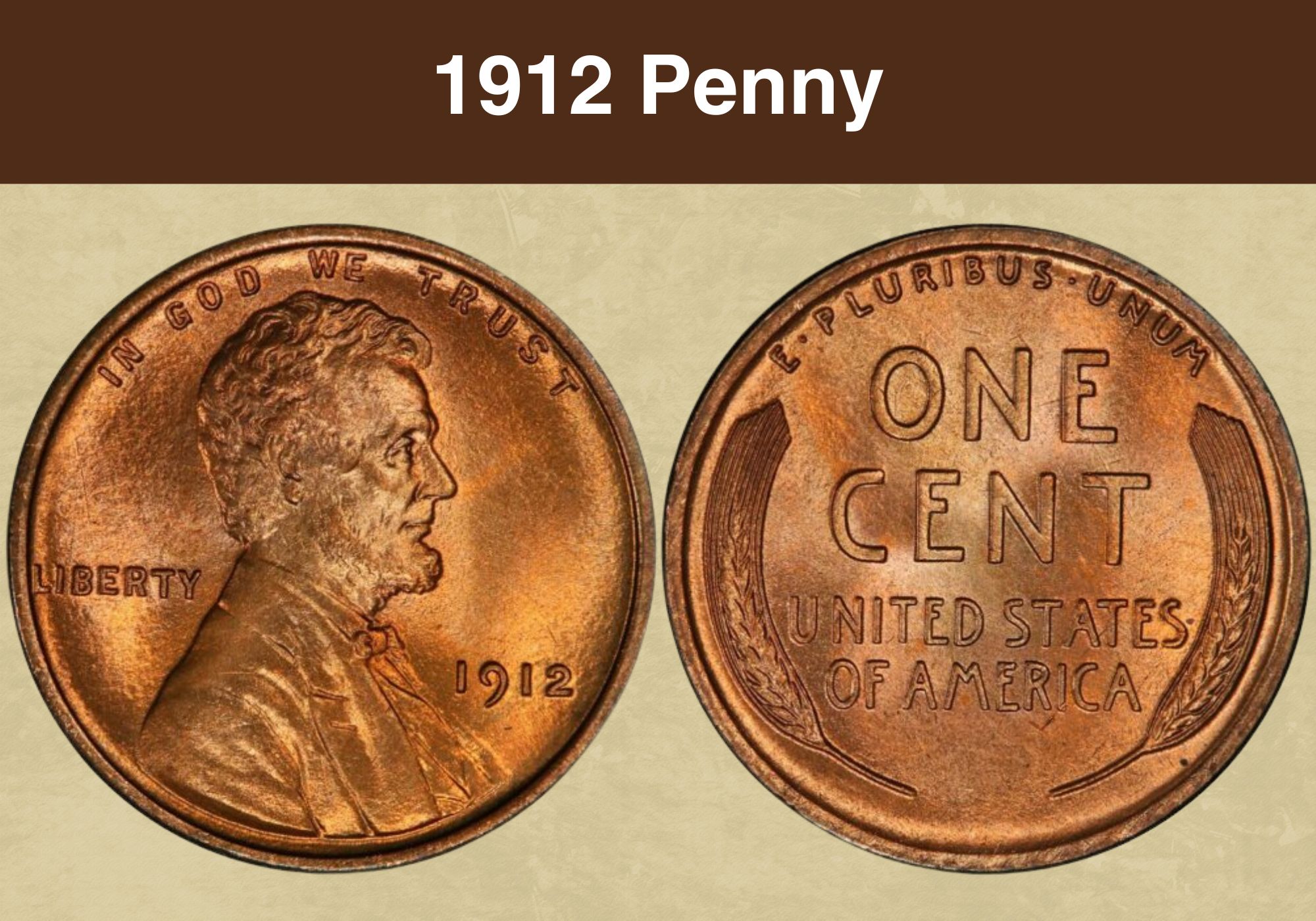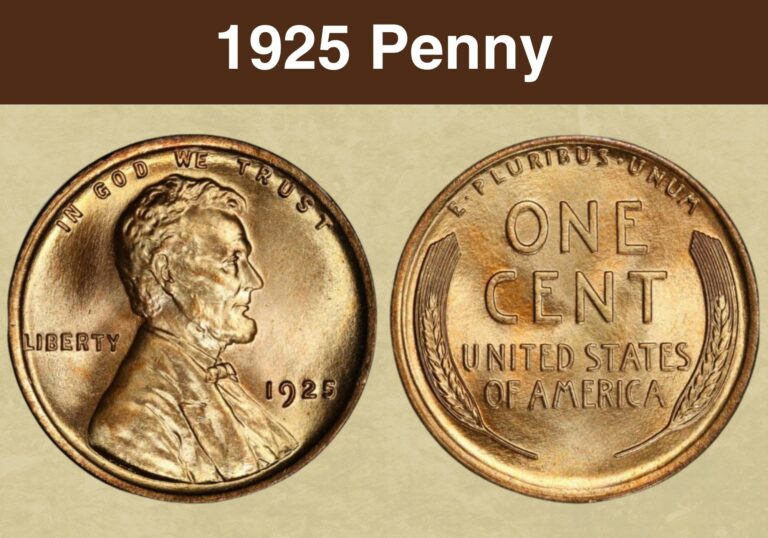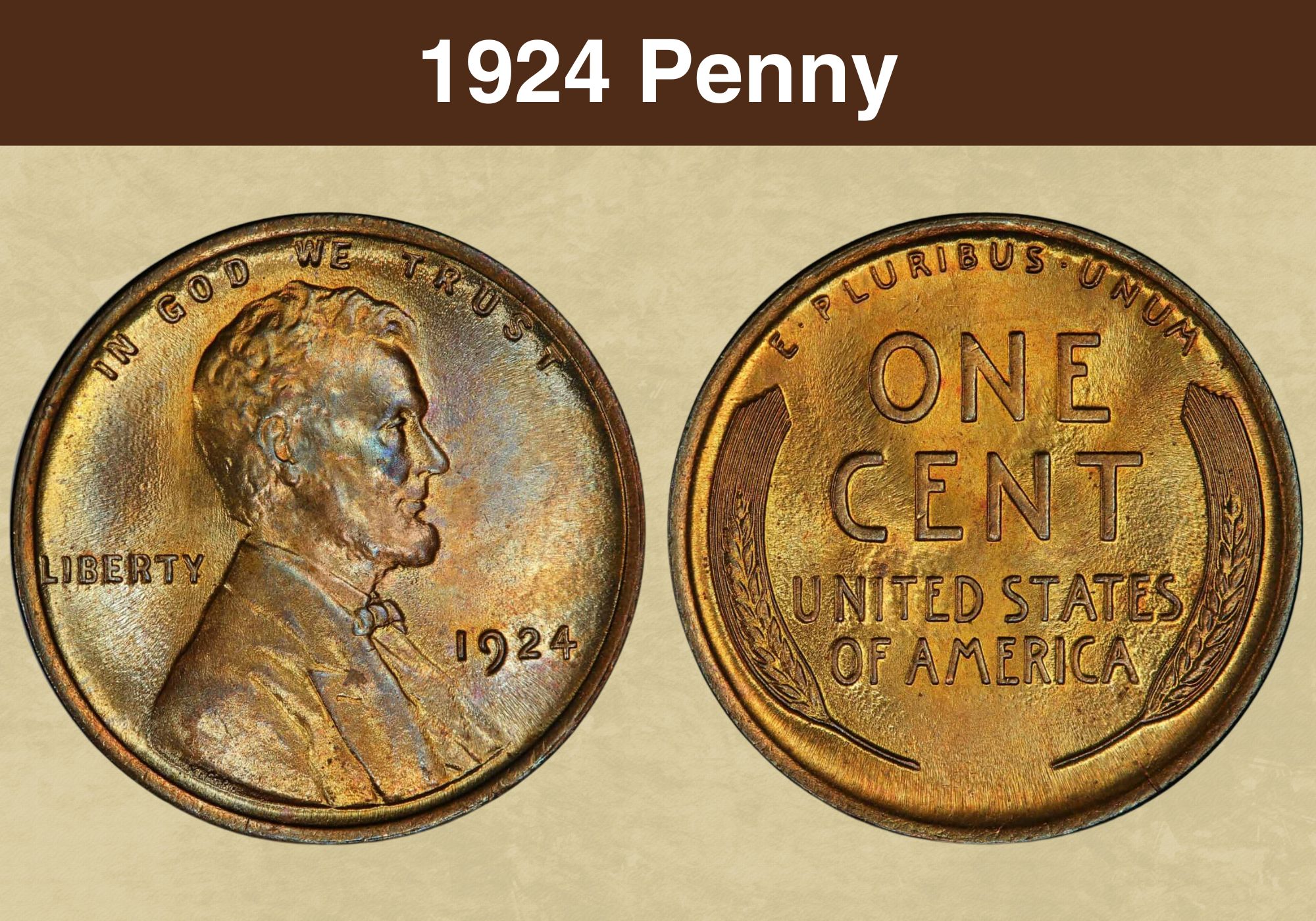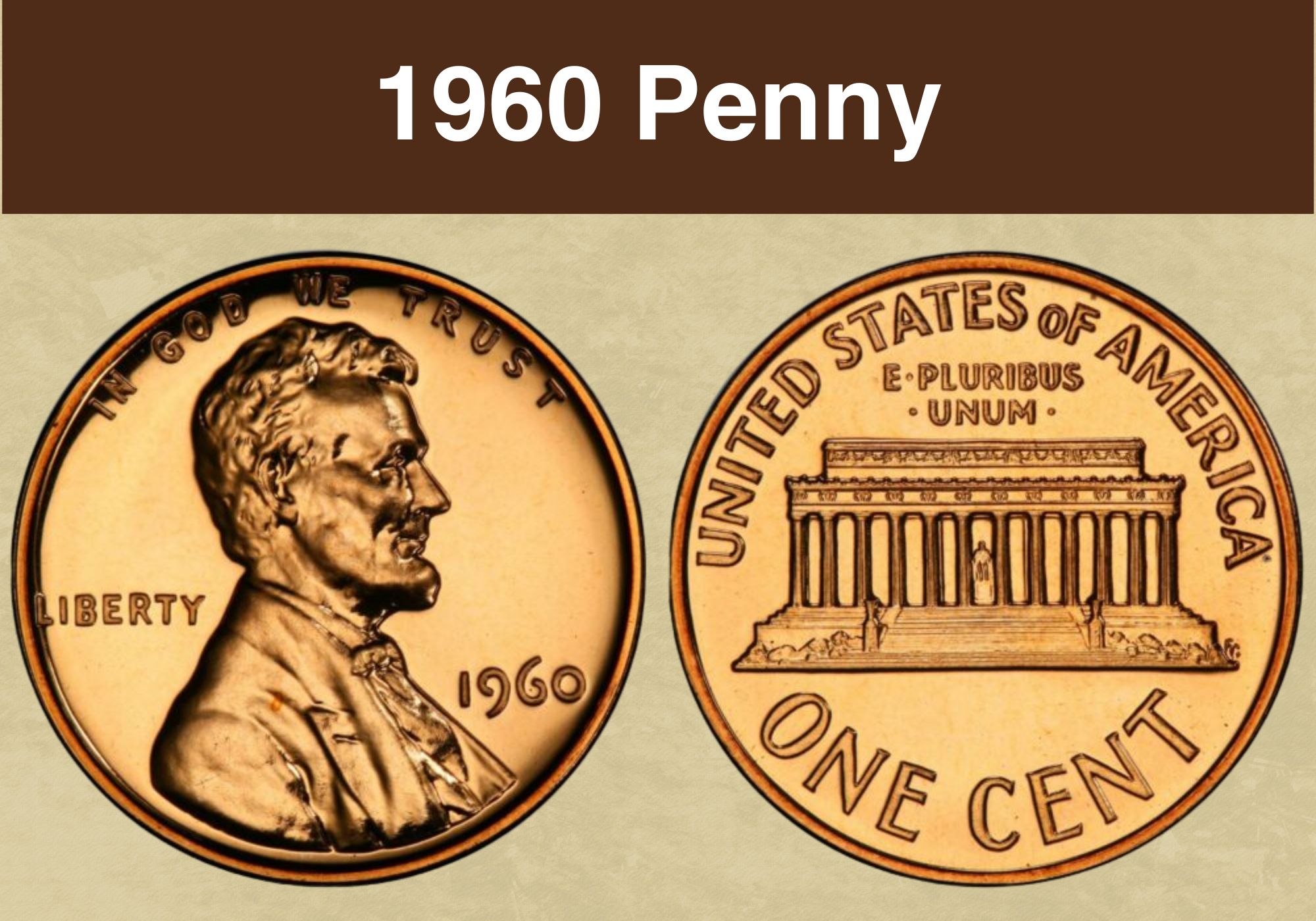
Coin Value Contents Table
- 1960 Penny Value Chart*
- History of the 1960 Penny
- Features of the 1960 Penny
- 1960 Penny Grading
- 1960 Penny Value Guides
- 1960 No Mint Mark Penny Value (Large Date)
- 1960 D Penny Value (Large Date)
- 1960 D Penny Value (Small Date)
- 1960 (P) Proof Penny Value
- Rare 1960 Penny Error List
- Where to Sell Your 1960 Penny ?
- FAQs
Is a penny dated 1960 worth holding on to? And just how much might it be worth?
That’s what we’re going to find out! We’re going to take a look at the 1960 penny value, and the factors that influence it. And we’ll learn about this coin’s history and design, and some of the interesting errors that slipped past the Mint.
Ready to find out more? Then read on!
1960 Penny Value Chart* |
|||
| Mint mark and variety | MS63 | MS65 | MS67 |
| 1960 (P) No Mint Mark Large Date Penny Value | $4 | $14 | $375 |
| 1960 (P) No Mint Mark Small Date Penny Value | $6 | $22 | $550 |
| 1960 D Large Date Penny Value | $8 | $16 | $475
|
| 1960 D Small Date Penny Value | $10 | $22 | $340 |
| PR60 | PR65 | PR69 | |
| 1960 (P) No Mint Mark Large Date Proof Penny Value | $5
Cameo: $7 Deep cameo: $8 |
$17
Cameo: $28 Deep cameo: $42 |
$150
Cameo: $315 Deep cameo: $2,600 |
| 1960 (P) No Mint Mark Small Date Proof Penny Value | $6
Cameo: $8 Deep cameo: $12 |
$20
Cameo: $50 Deep cameo: $75 |
$625
Cameo: $650 |
*Values for business strike coins are for those graded red (RD).
History of the 1960 Penny
1960 was the second year in which Lincoln pennies were produced with a reverse showing the Lincoln Memorial in Washington DC.
The design showed the former president’s statue on the Memorial’s portico, making it one of the few coins to have the image of the same person on both sides.
It was the work of the Mint’s Assistant Engraver at the time, Frank Gasparro. Gasparro would later go on to become Chief Engraver, a position he held for almost 16 years.
1960 saw well over 2 billion pennies come out of the coin presses at Philadelphia and Denver. Almost three quarters of those were struck in Denver. And both facilities produced coins with two variants, known as large and small date.
The Lincoln Memorial design was used on pennies for fifty years. It was finally replaced in 2009, with a new reverse commissioned to celebrate the bicentenary of Lincoln’s birth. The “Union shield” design appears on Lincoln pennies to this day.
Also read: 12 Most Valuable Lincoln Penny Worth Money
Features of the 1960 Penny
The Obverse of the 1960 Penny
The “heads” side of the 1960 penny is known to coin collectors as the obverse. But you don’t need to be a collector to recognise the image it shows. The same portrait of President Abraham Lincoln has been used on every cent since 1909.
It shows Lincoln in profile, and was the work of an artist named Victor David Brenner. Brenner had also designed the first reverse for the Lincoln cent, which showed two ears of durum wheat.
As was common practice for coin designers, Brenner proposed to sign his design. He originally suggested his signature be inscribed beneath the portrait of Lincoln. But when told this would not be acceptable, he suggested the reverse design bear his initials instead.
But some felt that the initials were too large and amounted to advertising. So despite Brenner’s protests, they were removed altogether.
Lincoln pennies went unsigned until 1918, when Brenner’s initials were reinstated. This time, they were placed on the obverse, tucked neatly away on the cut-off of Lincoln’s portrait. They were still in that position when the pennies of 1960 were struck.
Above the President’s portrait is the motto “IN GOD WE TRUST. The word “LIBERTY” is lower down, on the left as the coin is viewed. The date appears lower still, inscribed on the right.
With the large date variety, the top of the “9” is significantly higher than the top of the “1”. The “6” is also bigger than in the small date variety.
Coins struck in Denver will have a small “D” below the date. There are no mint marks on coins struck in Philadelphia.
The Reverse of the 1960 Penny
The 1960 pennies were the second mintage to have a reverse showing the Lincoln Memorial.
The country name appears at the top of the coin face, curving to run parallel to the upper edge. The denomination is written as “ONE CENT” and inscribed in large font. It’s positioned at the bottom, curving alongside the lower edge.
Immediately above the image of the Memorial is the motto “E PLURIBUS UNUM”. It’s Latin for “From the many, one”, and refers to the country’s formation from the union of states.
Other Features of the 1960 Penny
The pennies struck in 1960 are made of bronze – 95 per cent copper and 5 per cent tin and zinc. This changed two years later. At that point the tin was removed and the pennies were made with 5 per cent zinc – so they are more properly referred to as brass.
Each coin weighs 3.11 grams and is 19 millimeters in diameter. The copper content means that the color of individual coins can vary from bright red to a dull brown. New copper is red, while that which has been handled or exposed to the air gradually becomes brown.
Color plays an important part in the value of copper coins. The independent coin grading agencies place coins into one of three categories: red, red and brown, and brown.
For a coin to be graded red it must be red over at least 95 per cent of its total surface area. If it’s brown over at least the same area, it’s graded brown. And if there’s more of a mix, it’s red and brown.
All other things being equal, red coins are the most valuable and brown the least.
This YouTube video from CoinOpp provides more information on how to grade the color of your Lincoln penny.
Also read: 13 Most Valuable Wheat Penny Worth Money
1960 Penny Grading
| # | Grade |
|---|---|
| 1 | Basal State-1 |
| 2 | Fair |
| 3 | Very Fair |
| 4, 5, 6 | Good |
| 7, 8, 10 | Very Good |
| 12, 15 | Fine |
| 20, 30 | Very Fine |
| 40 | Extremely Fine |
| 50 | About Uncirculated |
| 60 | Mint State |
| 65 | Mint State |
| 70 | Mint State |
Please check our grading guides to know your coin scale, It’s the necessary step to know the exact value of your coin.
Check out now: How to Grade Lincoln Wheat Penny?
1960 Penny Value Guides
1960 No Mint Mark Penny Value (Large Date)
The Philadelphia Mint facility struck over 586 million cents in 1960. Today, around 170,000 of the large date variety are believed to survive.
They can be distinguished from small date versions by looking at the “9” and “6” in the year. If the top of the “9” finishes significantly higher than the neighboring “1”, it’s a large cent. And if you have one of each coin, you’ll also see that the “6” is also bigger in the large date example.
Most 1960 large date pennies from Philadelphia will only be worth their face value. And unless it has an interesting error, a coin will need to be red to be worth more.
The value of red coins depends on their condition. Coins are graded from 1 to 70, with 1 being the poorest and 70 the finest.
Red 1960 Philadelphia large date pennies are easy to find all the way up to MS65. (“MS” stands for “mint state” and indicates a coin that hasn’t been circulated.) The PCGS values a coin at that level at around $14.
But at MS67 and above, they are considerably rarer. Value jumps from $24 per coin at MS66 to $375 at MS67.
The finest examples known to exist are two coins certified by the PCGS at MS67+. Those are each valued at an impressive $8,750.
1960 No Mint Mark Penny Value (Small Date)
It’s not known how many of the pennies originally struck in Philadelphia in 1960 were the small date variety. But the PCGS estimates that around 130,000 of them survive today, somewhat fewer than large date examples.
As a result, values are generally higher. The size of the premium ranges from just a few dollars at lower mint state grades, to over $100 for the finest examples. But just as with the large date variant, coins will usually need to be red to be worth much more than their face value.
A red small date penny graded MS65 is worth around $22, $6 more than the large date equivalent. And there’s a big jump in value between MS66 and MS67 – from $42 to $550.
The finest examples to have so far come to light are three coins graded MS67+. The PCGS values those at a cool $10,500 each.
1960 D Penny Value (Large Date)
In 1960, almost three times as many pennies came out of the Denver coin presses as the Philadelphia ones. More than 60 years on, it’s estimated that around 120,000 survive. Roughly half of those are believed to be gem quality coins graded MS65 or higher.
The Denver facility produced both large and small date variants. The difference between the two is the same as between the Philadelphia equivalents – a taller “9” and “6” on the large date coins.
Red coins are generally the only ones to be worth much more than their face value. (The exception to this is error coins, and we’ll look at those later.)
A red 1960 large date Denver penny graded MS63 is worth twice as much as the Philadelphia equivalent, at $8.
There’s a small premium at MS65 ($16 for Denver, compared to $14 for Philadelphia).
And at the top grade for 1960 large date Denver pennies, MS67, the value is $475. That’s almost $100 more than a Philadelphia cent at the same grade.
1960 D Penny Value (Small Date)
The small date variety of 1960 Denver pennies survives in higher numbers than its large date counterpart. Around 180,000 are estimated to remain to this day. But their distribution across grades is somewhat different.
Numbers in the lower mint state grades are actually lower. That leads to a small premium for small date pennies at MS63 ($10) through to MS66 ($28). Values for both variants are the same at MS66+. But at higher grades, the small date variety is more affordable.
A small date red coin graded MS67 is valued by the PCGS at $475. And the very finest examples, six coins graded MS67+, are each worth around $4,000.
1960 (P) Proof Penny Value
As well as producing coins for circulation, the Philadelphia Mint facility struck just under 1.7 million proofs. These were aimed at collectors and were struck using special dies and planchets.
Like the business strikes, proofs also exhibit the large and small date variants. They may be graded red, cameo or deep cameo. Cameos are proofs with an attractive contrast between reflective fields and frosted devices. With deep cameos, that contrast is especially strong.
Values for red large date proofs range from $5 at PR60, through to $150 at PR69. Red small date proofs are represented at the same grades, and range from $6 to $625.
The cameo designation adds a premium, with large date cameos ranging from $7 at PR60, to $2,100 for one coin graded a perfect PR70. Deep cameos of the same variant are $8 at PR69 and $2,600 at the highest available grade, PR69.
For small date cameos or deep cameos, a coin graded PR60 can be yours for around $12. One cameo has been certified by the PCGS at PR70, and that sold at auction in May 2023 for $4,080.
The finest small date deep cameos certified by the PCGS are graded PR68+. Two coins have been assessed at that level, each valued at $1,350.
Also read: 17 Most Valuable Indian Head Penny Worth Money
Rare 1960 Penny Error List
1960 D Over D, Small Over Large Date Penny, Repunched Mint Mark
Some of the pennies struck at Denver in 1960 had their mint marks repunched. You’ll probably need a microscope or loupe to spot the ghost of the first “D” behind the second.
But that wasn’t the only error. Somehow, a die was struck by a hub with the small date design, after it had been struck by the hub with the large date. As a result, the die had doubling on the date, which was then transferred to all the coins it struck.
Pennies of all colors with the small over large date error can be worth much more than their face value.
Even a brown coin graded 8 is worth a couple of dollars. That rises to $8 for one graded extremely fine (XF45). And the values of brown mint state coins range from $34 at MS60 to $135 at MS65.
Red and brown coins in mint state start at $50 for a coin graded MS60. Quality tops out at MS66, and the single red and brown coin certified by the PCGS at that level is worth around $400.
Values for red coins range from $75 at MS60 to $1,375 at MS66+.
1960 (P) Small Over Large Date Proof Penny, Repunched Mint Mark
A similar hubbing mix-up occurred in Philadelphia with the dies used to strike proof coins.
Somehow, three different proof dies were struck by hubs with both small and large date variants. Two of the dies were hubbed by the large date design, followed by the small. For the third die, the large date came second.
Coins struck by a die where the large date design was hubbed first are known as “Small over large date”. If the die was struck by the hub with the small date first, they’re “Large over small date”.
Small over large date proof pennies range in value from $50 for a red or cameo coin graded PR60, to $4,150 for a red coin graded PR69. The finest deep cameo is graded PR66 and worth around $2,000.
Large over small date proof pennies start at $30 for a red coin graded PR60. A cameo at the same grade is worth about $5 more.
There are no deep cameos amongst this variety. The finest cameo to have come to light is graded PR68 and worth around $2,500. The finest red coin is graded a point higher and valued at $8,500.
This YouTube video from Couch Collectibles shows you how to identify Mint errors on 1960 pennies.
Also read: 11 Most Valuable Wheat Penny Errors
Where to Sell Your 1960 Penny ?
Now that you know the value of your coins, do you know where to sell those coins online easily? Don’t worry, I’ve compiled a list of these sites, including their introduction, pros, and cons.
Check out now: Best Places To Sell Coins Online (Pros & Cons)
FAQs
How much is a 1960 penny worth with a large date?
That depends on the color, condition and mint mark of the coin.
If it’s brown or red and brown, it won’t be worth more than its face value unless it has an interesting Mint error.
If it’s a red coin with minimal signs of wear, it could be more valuable. Values range from under $5 for coins in the lowest mint state grades, to around $400 for the very finest examples.
Top quality coins are worth more if they have a Denver mint mark.
Which years of pennies are valuable?
A penny from almost any year can be valuable if it’s colored red and in top-notch condition. The exact value will depend on how many other coins exist in the same or better condition.
Pennies with Mint errors can be valuable too. The rarer the type of error, the more valuable the coin. Coins with the rarest errors can be worth tens of thousands of dollars.

